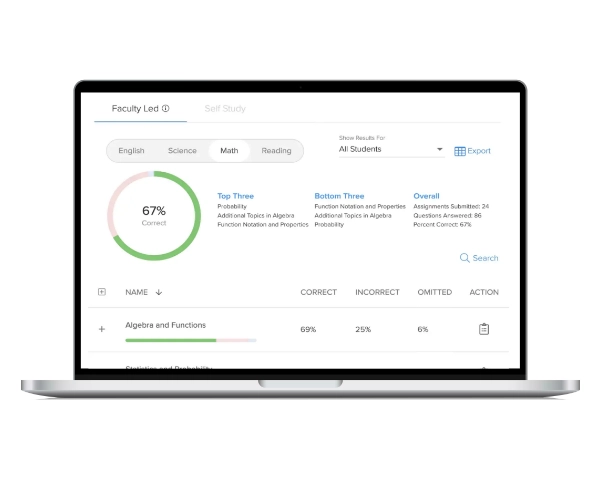Deciding on the right college credit program(s) for your high school can quickly begin to feel like a confusing mish-mash of acronyms and information. In this article, we’ll clearly lay out the pros and cons of AP®, IB®, dual enrollment, and dual credit programs, so you can choose the right one(s) for your students.
What are College Credit High School Programs?
Anyone who has braved the long lines of shopping centers during the holiday months knows that most people appreciate a good deal. Who hasn’t become excited about two items for the price of one? College credit high school programs are, in a way, just like a great two-for-one deal. In short, these programs are a means for students to take on the responsibility of college-level courses–and possibly earn credits for them, too–while they are still in high school.
Why College Credit High School Programs Benefit Students
These programs are a great way for high school students to ease into college-level coursework. Classes in these programs are taught at the same level as those found on actual college campuses. With their higher expectations and requirements, these programs prepare students for college academics in a way that no standard high school class ever could.
Since college credit high school programs provide the same rigor as their collegiate counterparts, they do an excellent job showcasing a student’s college-readiness on admissions applications. Admissions boards look at a number of factors when determining who will be accepted into their programs, and when a student has already shown they can handle a college-level workload, those committees are more likely to believe the student will succeed at their school.
Program Options: AP, IB, Dual Credit, and Dual Enrollment
There are several options for students who want to get ahead with college-level classes: AP, summer for-credit courses, Cambridge AICE classes, etc. For the purpose of this article, we’re going to explore four of the most common ways high school students earn college credits: Advanced Placement®, International Baccalaureate®, Dual Credit, and Dual Enrollment.
Advanced Placement®
Advanced Placement, or AP, is the most popular college readiness program. AP is a national program created by the College Board® that allows high school students to take college-level courses within the context of a regular school day. Over 70% of public high schools offer AP classes in the U.S. and there are thirty-eight courses available at the time of this publication. All AP classes include a final AP exam, and in many cases, a passing score of 3 or higher can provide students with college credit.
Pros:
- Many high schools weigh AP class grades, meaning a good grade can result in a higher GPA.
- Many colleges award students course credits for AP classes if a student earns a high enough score on the AP exam.
- There is research to support that students who complete these courses in high school are more likely to attend a four-year college or university, and complete their degree within that time frame.
- Studies show that, on average, students earn higher GPAs in college if they have passed an AP exam.
- Many schools offer AP “open enrollment,” so any student who wishes to enroll in an AP course, can.
- Since so many schools offer AP courses, there are a plethora of AP teacher resources available for instructional support.
- In terms of dual credit vs. AP credits, colleges are more likely to accept the latter than the former.
Cons:
- AP courses are challenging and require a lot of time for work and study.
- Not all schools offer AP courses, so if a student cannot enroll through their high school, they must sign up and prepare for an AP test they wish to take completely on their own.
- Each AP exam costs money, although some districts may pay testing fees and students who qualify can have their testing fees reduced.
International Baccalaureate®
International Baccalaureate, or IB, is an internationally-focused program that originated in Geneva, Switzerland. Rather than having students choose which college-level courses to take, secondary schools that participate in the IB program have students complete an entire 2-year degree that focuses on six core areas of study. At the conclusion of the program, students complete written exams in each of the major subject areas, earning a maximum of seven points per exam. Students who earn at least 24 points from their assessments receive their IB diplomas and scores may be sent to their colleges of choice.
Pros:
- Many colleges offer students who earn at least a total of 24 points on their IB exams college credits.
- IB has a focus on “trans-disciplinary studies,” so students develop great critical thinking skills. The ability to think critically is a strong indicator of college readiness in students.
Cons:
- IB classes are extremely rigorous and not a fit for students who aren’t willing to commit to hours of studying and homework each week.
- IB is only offered at approximately 950 high schools in the United States because campuses must each undergo a rigorous, multi-year process to become IB-certified. School staff members must also undergo specific IB training and/or certification requirements in order to teach IB classes.
- IB certification is expensive. Each application a school submits for IB certification in the United States costs $12,500.
- Each IB exam costs money, although some districts may pay testing fees and students who qualify can have their testing fees reduced.
Dual Enrollment
Dual enrollment (otherwise known as concurrent enrollment), in its simplest terms, just means a student is enrolled in courses both on a high school and collegiate level. Since dual enrollment does not necessarily mean a student is taking a college course in lieu of a standard high school class, it opens the door for students who want to take college-level courses that would not otherwise be available on a high school level.
Pros:
- Since dual enrollment courses are, in fact, actual college courses, the credits students earn from them are typically accepted by most colleges and universities.
- Dual enrollment courses allow students to take college classes that would not typically be available to high school students.
- Students only have to pass the course to get credit, they don’t have to pass a final exam.
Cons:
- Not all dual enrollment courses offer dual credit, so students may not receive credits that count toward their high school diploma.
- Students who participate in extracurricular activities on campus might have scheduling conflicts.
- Dual enrollment courses are not standardized and therefore can lack rigor.
- Since students who take dual enrollment courses are often in class with older, full-time college students, they can become overwhelmed at the difficulty of the class. This can frustrate and even discourage students who are not fully ready for a college experience.
Dual Credit
Dual credit is a college credit high school program that also allows students to take college-level courses (typically) within the context of a regular school day. Teachers of these classes are required to have a master’s degree and at least 18 hours of graduate credits in their subject area, so students often end up attending dual credit courses on-campus or online through a local college. Dual credit courses are called “dual” because the credits awarded to students who pass them count toward both their college and high school transcripts. The most common dual credit courses high schools offer are in core subject areas and foreign languages.
Pros:
- Students do not have to pass a standardized exam to earn dual credit for these courses. As long as they pass the course, they will earn credit for both high school and college.
- Dual credit students pay less for college courses than traditional college students.
Cons:
- Dual credit courses do not typically have “open enrollment,” and usually require a prerequisite of a B average or higher in related content areas in order to take the dual credit course.
- Dual credit courses are not standardized and therefore can lack rigor.
- Dual credit courses are not offered in every state, and as a result, many colleges do not accept credits earned through dual credit coursework. In terms of dual credit vs. AP credits, for example, colleges are more likely to accept the latter than the former. Even in Texas, where all public colleges must–by law–accept dual credits, those credits might not necessarily count toward a students’ specific degree. Istead, they may only count as elective credits.
AP vs IB vs Dual Enrollment vs Dual Credit at a Glance
| Advanced Placement (AP) | International Baccalaureate (IB) | Dual Enrollment | Dual Credit | |
|---|---|---|---|---|
| Description | Allows students to take college-level courses at school | Students complete a 2-year degree focused on six core areas of study | Students enroll in courses on both a high school and collegiate level | Students take college-level courses that count toward both high school and college transcripts |
| Eligibility | Some schools have prerequisites and grade requirements; Others have open enrollment policies | Certified IB schools may offer all of their students the opportunity to earn their IB diploma | Most states require students to be a junior or senior and maintain a minimum GPA | Students who meet their school’s dual credit eligibility requirements may enroll |
| College Credit | Majority of colleges award credit for the most common AP courses | Some schools award credit for a full IB diploma, while others award credit for individual IB exams | Course may or may not also count toward their high school diploma | If course credits are accepted, they count toward both college and high school transcripts |
| Teachers/Instructors | Most schools require a teaching license in a field related to a teacher’s course subject and 3 year’s experience | To qualify for IB certification, teachers must have completed a graduate degree in their subject area and have at least 3 year’s experience | Most DE teachers must have a master’s degree and 18 graduate hours in an academic field related to their subject area | Must be faculty members of the college or meet the same standard requirements |
| Summative Testing | Students must take a summative exam and earn a 3-5 score in order to earn course credit | Students must take summative exams in six areas of study and earn at least 5 out of 7 points to earn course credit | Students must fulfill their course’s specific passing requirements to earn course credit | Students must fulfill their course’s specific passing requirements to earn course credit |
| Location | High school campus | High school campus | Local/online college or university | High school campus (with an approved instructor) or on college campus |
| Rigor | College-level courses that many students find challenging | College-level courses that many students find challenging | Not generally considered as rigorous as AP courses | Doubts about rigor have led some colleges to limit the credits accepted |
| Cost | No student enrollment fee, but exams cost $96; fee is reduced/covered for many students | Many IB schools cover exam costs ($70 each); costs $12,500 for a U.S. school to become IB certified | Students pay $26 per credit hour; exam retakes are $10/exam | Costs vary, depending on state/local regulations |
| Resources Materials | Variety of AP teacher resources, including UWorld’s Learning Tools for AP Courses | Variety of IB resources, but not as many as other programs in the U.S. (not as many American IB schools) | Uses same resource materials as other related college courses | Uses same resource materials as other related college courses |
| Accessibility | As of 2019, there were 22,678 U.S. high schools with AP classes | Currently, there are just 950 U.S. high schools that offer IB classes | As of 2018, 82% of U.S. high schools offered dual enrollment opportunities | Dual credit accessibility varies widely from state to state |
| Impact on High School GPA | In many high schools, AP classes can increase a student’s GPA | The International Baccalaureate systems translate their 1-7 scoring system into the standard GPA | Dual enrollment courses are weighted on a 5.0 GPA scale, rather than a 4.0 scale | Dual credit courses may be weighted with an extra .5 point, but it varies by state. |
Additional Things to Consider When Choosing a College Credit Program
When deciding on options for students who are preparing for college, it’s not a matter of IB vs AP, Dual Enrollment vs Dual Credit, or Dual Enrollment vs AP. School district leaders must choose a program that aligns with their curriculum requirements, state laws, proximity to community colleges, and student demand. Other things district and campus administrators may consider is the time they have to dedicate toward college credit programs, whether in regards to hours required for staff training, or even availability of program-specific study resources.
When considering IB vs AP, for example, one might consider how both have a variety of online study programs–such as UWorld’s Learning Tools for AP Courses–that are widely available to students who want to review course concepts and study for culminating assessments. On the other hand, dual credit and concurrent enrollment courses typically expect students to study the materials their professors provide in class. Some programs cost more than others, as well. Many schools, for example, cannot afford to budget $12,500 for IB certification, let alone the cost of multi-day IB training sessions for all staff members.
Key Takeaways
At the end of the day, there is no such thing as a “one-size-fits-all” college credit high school program. Regardless of whether a school offers AP courses, dual credit and/or dual enrollment options, or a two-year IB degree program, preparing high school students for college by exposing them to college-level classes is a great idea.
Still unsure about the difference between AP, IB, Dual Credit and Dual Enrollment? Learn more in this quick, can’t-miss webinar designed for administrators on the go!”
Learn more about how UWorld helps educators prepare students for college readiness by providing exceptional AP content and insightful data with our Learning Tools for AP Courses.




